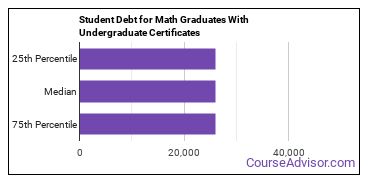Undergraduate Certificates in Mathematics
Featured schools near , edit
Education Levels of Math Majors
During the 2020-2021 academic year, 17 students earned their undergraduate certificate in math. The following table shows the number of diplomas awarded in math at each degree level.
| Education Level | Number of Grads |
|---|---|
| Bachelor’s Degree | 21,425 |
| Associate Degree | 4,841 |
| Master’s Degree | 2,533 |
| Doctor’s Degree | 1,149 |
| Basic Certificate | 155 |
| Graduate Certificate | 82 |
| Undergraduate Certificate | 17 |
Earnings of Math Majors With Undergraduate Certificates
We are unable to calculate the median earnings for math majors with their undergraduate certificate due to lack of data.
Student Debt
The median student debt for graduates holding an undergraduate certificate in math is $26,000. The school you go to and how long it takes you to graduate, among other things, can cause this number to vary. The chart below shows the range of accumulated debt loads. On the high side of the range, $26,000 is the debt load, and the debt load on the low side is $26,000.

Student Diversity
More men than women pursue undergraduate certificates in math. About 52.9% of graduates in this field are male.
| Gender | Number of Grads |
|---|---|
| Men | 9 |
| Women | 8 |

The racial-ethnic distribution of math undergraduate certificate students is as follows:
| Race/Ethnicity | Number of Grads |
|---|---|
| Asian | 0 |
| Black or African American | 1 |
| Hispanic or Latino | 2 |
| White | 12 |
| International Students | 0 |
| Other Races/Ethnicities | 2 |

Explore Major by State
Alabama
Arkansas
Connecticut
Florida
Idaho
Iowa
Louisiana
Massachusetts
Mississippi
Nebraska
New Jersey
North Carolina
Oklahoma
Rhode Island
Tennessee
Vermont
West Virginia
Related Majors
Below are some popular majors that are similar to math that offer undergraduate certificates.
| Major | Annual Degrees Awarded |
|---|---|
| Applied Mathematics | 9 |
| Other Statistics | 4 |
References
*The racial-ethnic minority student count is calculated by taking the total number of students and subtracting white students, international students, and students whose race/ethnicity was unknown. This number is then divided by the total number of students at the school to obtain the percentage of racial-ethnic minorities.
More about our data sources and methodologies.
Featured Schools
 Request Info
Request Info
|
Southern New Hampshire University You have goals. Southern New Hampshire University can help you get there. Whether you need a bachelor's degree to get into a career or want a master's degree to move up in your current career, SNHU has an online program for you. Find your degree from over 200 online programs. Learn More > |

